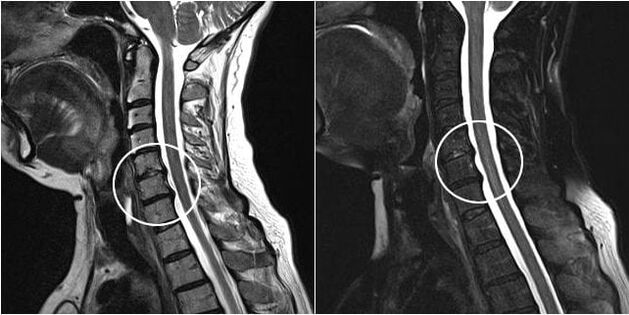
Cervical fibroids are diagnosed in women more often than in men. And this is not only due to the lower strength of the tendon and ligament apparatus, the weakness of the muscle corset. Throughout her life, a woman's body is subject to fluctuations in hormone levels, which can adversely affect the condition of cartilage and bone tissue. But the conservative and surgical treatments for fibroids in both sexes are practically the same.
Features of female osteonecrosis
Cervical osteosarcoma in women develops and progresses according to the same scenario as in men. The disc loses its ability to retain moisture, begins to collapse, and pulls the bone, ligament, and tendon structures in the process of destruction. But because the neck muscles are weak, the vertebrae segments are more fragile, so the first symptoms of the disease in women appear faster. Already in the early stages of development, there may be marked discomfort that limits mobility.
It should be noted that the stress resistance of women of all ages is lower. After learning about the possibility of a complete cure for osteonecrosis, they can lead themselves to depression by experience. Therefore, antidepressants, antipsychotics, tranquilizers, sedatives are often included in the treatment regimen.
Causes of the disease in women
The main reason why the discs in women are damaged more often is due to a decrease or increase in the amount of hormones in the body. After the onset of natural menopause, the production of estrogen, which is involved in the regulation of cartilage and bone tissue biosynthesis, gradually decreases. The drop in estrogen levels during menopause leads to damage to the discs, which causes the development of osteoporosis (increased fragility of bones).
Women monitor their weight, so they often refuse calcium-rich foods - sour cream, cheese, peas, soybeans, beans. And if this diet is followed, not only the body weight decreases, but also a deficiency of the most important trace elements and vitamins, which leads to premature destruction of the intervertebral discs.
Symptom
At the first radiographic stage, signs of osteonecrosis are weakly expressed. Only the uneven surface of the intervertebral discs is noted. As a result, a woman feels only slight discomfort in her neck after exertion or in a bowed position for a long time. But gradually the intensity of the pain increased. It occurs not only when turning and tilting the head, but also when resting. In the absence of medical intervention, the pathology continues to progress steadily. Due to the invasion of bone cells, the disc of the vertebral artery is violated, the following clinical manifestations occur:
- hypertension;
- headache (cervical migraine), dizziness, before fainting;
- decreased vision and hearing, double vision of objects in front of the eyes, tinnitus;
- fatigue, lethargy, sleep disturbances;
- tickling, "coma" sensation in the throat.
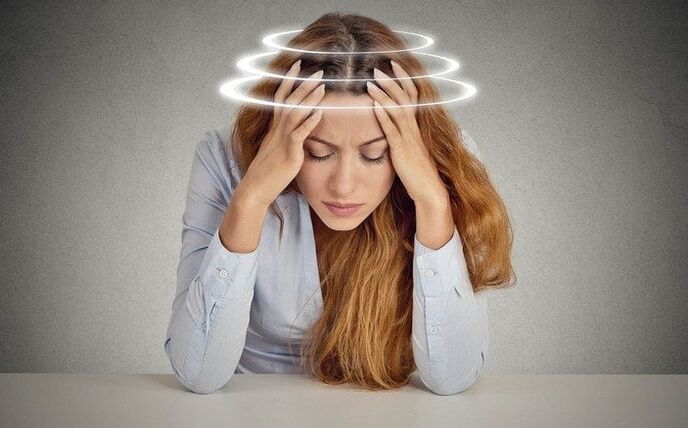
In addition, when tilting or turning the head, a crunch is heard and the mobility of the cervical region is limited.
Diagnosis of disease
The primary diagnosis can be made on the basis of physical examination, patient complaints, and the results of several functional tests to assess range of motion, reflexes, and sensitivity. To confirm it, X-rays were taken in 2 projections. The study provides information not only for detecting osteonecrosis but also for determining its stage and extent of disc and vertebrae damage. Discography allows a precise examination of the affected discs, and if damage to the nerve pathways is suspected, the patient undergoes an electrophysiological diagnosis:
- potentials are aroused;
- neuroelectricity;
- electromechanical.
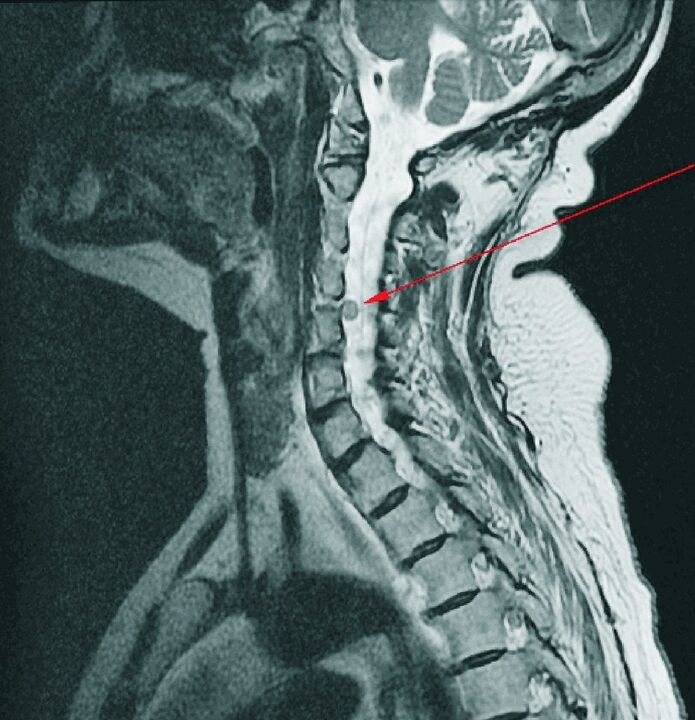
CT, MRI serve as additional diagnostic methods, often used to evaluate the condition of the spinal cord, detect complications of protrusion - disc or herniated disc. These studies were conducted to differentiate cervical spondylosis from tuberculosis spondylitis, osteomyelitis, benign and malignant tumors, ankylosing spondylitis, and rheumatoid arthritis.
Acute first aid
During recurrent cervical spondylosis, the woman experiences neck pain so severe that she is afraid to turn or tilt her head. To reduce its intensity, lie down on a hard surface. There needs to be a position of the body for the pain to ease. If, on your doctor's recommendation, you have purchased a Shant collar or semi-rigid bandage, it must be worn on the go.
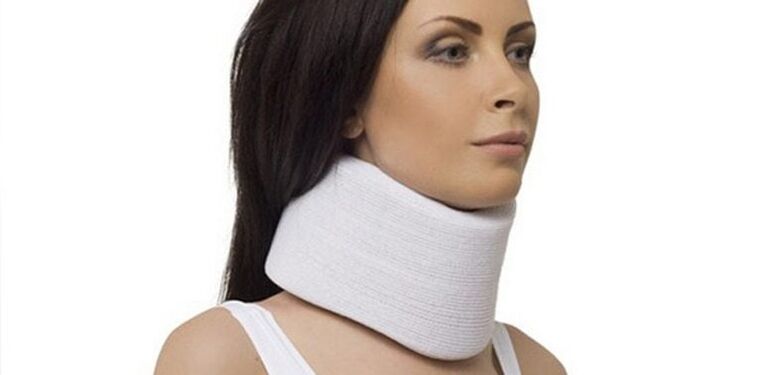
To stop the pain, you can take a non-steroidal anti-inflammatory drug (NSAID). Ointments and gels with NSAIDs have a pronounced analgesic effect.
When giving first aid, the use of heat or cold is undesirable. Often, relapses occur due to muscle spasticity, and cold compresses will only increase skeletal muscle tension. Dry hot compress is an effective way to eliminate symptoms, but only in the absence of inflammatory processes in the soft tissues of the neck.
How to treat cervical fibroids in women?
Osteoma of any localization has not yet been completely cured. A neurologist or chiropractor will certainly explain to women the meaning and principles of upcoming therapy. Treatment is aimed at achieving stable remission. At this stage, any painful sensations occur extremely rarely and complete range of motion is preserved.
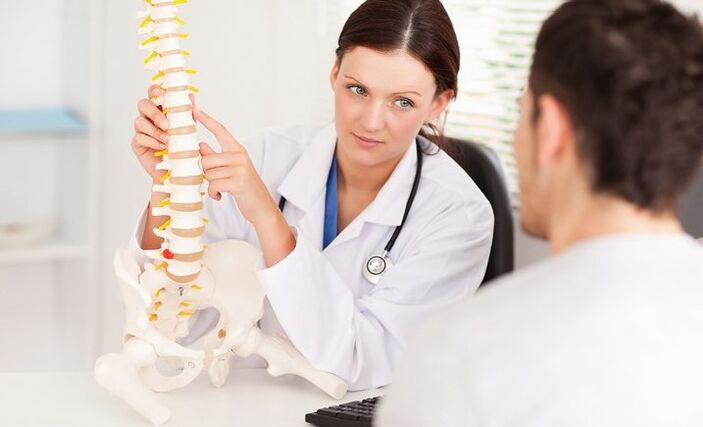
It is not possible to be limited to the use of drugs alone, since the means of restoring the disc and vertebrae have not yet been synthesized. It is necessary to observe all the instructions of the doctor - to participate in physiotherapeutic activities, massage, therapeutic gymnastics and gymnastics.
Right from the first days of treatment, patients are recommended to wear a Shants necklace - an orthopedic device that helps stabilize discs and vertebrae. They prevent displacement of vertebral structures, thereby reducing the likelihood of recurrence.
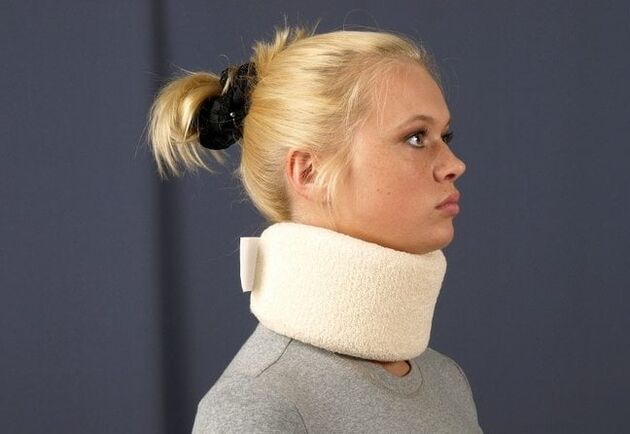
Overview of therapeutic drugs
Sometimes during exacerbations of osteosarcoma of the neck, burning, stabbing pain occurs due to invasion of the spinal roots. They can only be eliminated by intramuscular injection of NSAID solutions. And if they don't work, blockades with anesthetics and hormonal agents are used. Glucocorticosteroids are generally not used because of their negative effects on internal organs, cartilage tissue, and bone.
To get rid of mild pain, women will be allowed to take NSAIDs in the form of tablets or capsules. Non-steroidal drugs in the form of gels and ointments are prescribed for mild pain relief, as well as to reduce the dose of systemic drugs.
| A class of drugs for the treatment of cervical osteonecrosis | Therapeutic action |
|---|---|
| Chondroprotectors | Partial restoration of the cartilage tissue of the disc |
| Means improve blood circulation | Eliminate oxygen and nutrient deficiency, stimulate regeneration |
| B group vitamins | Normalizes the transmission of impulses to the central, peripheral nervous system |
| Muscle relaxants | Relax skeletal muscles, eliminate muscle spasms |
| Warming ointment | Accelerates blood circulation, has analgesic, anti-secretory effects |
| Antidepressants, tranquilizers, tranquilizers | Reduce anxiety, restlessness, sleep disorders |
Therapeutic exercises, gymnastics, exercises
The most effective way to treat osteonecrosis is daily exercise therapy. With the help of loads on the cervical spine, the muscle corset is strengthened, the blood supply to the tissues with nutrients is improved and the risk of exacerbations is reduced. Exercise should be started as soon as the acute pain stops. Exercise therapists prescribe a series of exercises individually for a woman, taking into account her physical condition and the severity of the pathology. All movements are performed rhythmically, with small amplitudes. This will strengthen the muscles without damaging the cartilage tissue. Physical therapy exercises recommend doctors:
- Sit up straight, put your hands under your chin. Try to tilt your head, resist with a brush;
- In a sitting position, place your hand on your cheek. Tilt the head to one side, prop with the brush;
- Stand up, put your hands on your belt. Turn your head first in one direction, then the other, without turning your head back much.
With osteonecrosis, the patient is recommended to swim, yoga, Pilates, water aerobics, Nordic walking. Cycling, running, and lifting weights are prohibited.

Nutrition and diet
With cervical fibroids, nutritionists recommend limiting the use of alcohol, coffee, and strong tea. These drinks interfere with calcium absorption, quickly excreting calcium from the body. Priority should be given to lightly salted mineral waters, fruit juices and jellies, vegetable juices, and drinks from berries. The optimal amount of water to drink is 2-2. 5 liters per day.
Need to give up fast food, semi-finished products, smoked meat, fatty meat. The daily menu should include fresh fruits and vegetables, cereals, dried white or rye bread, and fermented dairy products. Useful turkey, chicken breast, rabbit meat, lamb. 2-3 times a week you need to eat some oily fish, such as salmon or Norwegian herring.
It's better to give up fried foods altogether. The most useful products are baked in foil, stewed in water or steamed.
Physical therapy
At the rehabilitation stage, the patient is assigned to do physical therapy 5-10 sessions. Electrophoresis or ultrasound with chondroprotectors, calcium salt solutions, vitamins of group B are performed to restore cartilage tissue, improve clarity and increase the strength of the ligamentous apparatus. Procedures are similar, but only with glucocorticosteroids, analgesics, and local anesthetics in the subacute phase, aimed at reducing pain and inflammation.

The following physical therapy procedures may also improve women's health:
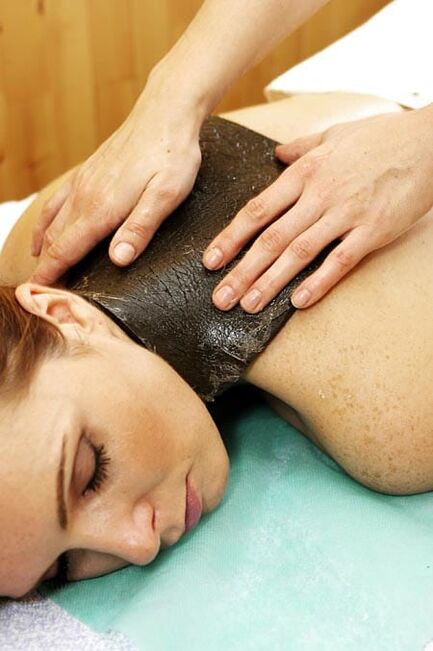
- UHF therapy;
- acupuncture therapy;
- galvanic current;
- laser therapy;
- shock wave therapy.
Applications with ozokerite, bischofite, paraffin are used. The use of mud and mineral water therapy, placing leeches in medicine has been shown to have a good effect in the treatment of cervical osteonecrosis.
Massage
During massage, a mechanical impact is made on the muscles of the entire back, not just the cervical area. But for them, the specialist focuses special attention. As a result of kneading, smoothing, performing pressing and tightening movements, the contracted skeletal muscles are relaxed, the ligaments are strengthened and blood circulation is improved. In the treatment of osteonecrosis, the following types of manual and hard massage are used:
- classic;
- the point;
- vacuum cleaner;
- Swedish;
- segment.
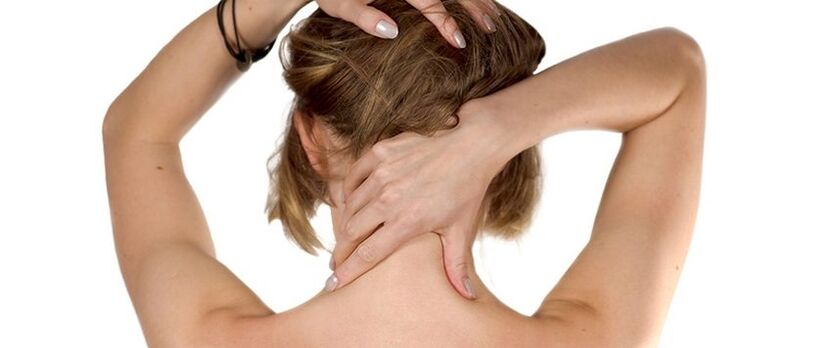
Pharmacies and medical device stores sell electric manual massagers. They are equipped with special nozzles, speed controllers. And its comfortable long handle allows you to massage the back of your neck independently.
Folk remedies
In folk medicine, for the treatment of osteonecrosis, people use homemade ointments, tinctures and balms, compresses, decoctions and tinctures. Officials are skeptical of such methods of treating degenerative-dystrophic pathologies due to their low clinical effectiveness. The exceptions are Roman chamomile herbal teas, St. John's wort, rose hip extract.

Characteristics of the treatment of older women
Therapy for aged patients is carried out using the same techniques as treatment for young women. But when determining the dosage regimen, the neurologist takes into account the presence of chronic pathologies in the elderly, a decrease in the functional activity of the liver, kidneys and gastrointestinal tract. Doctors select drugs, the use of which has a mild effect on internal organs, and reduces the risk of adverse reactions.
What are dangerous cervical fibroids?
The leading signs of cervical necrosis are similar in both sexes. But neurological symptoms are more pronounced in women. They are often diagnosed with compromised spinal roots and vertebral arteries, which supply nutrients to the brain.
With grade 2 and 3 cervical spondylosis, often the spinal roots are violated, leading to acute pain, loss of reflexes, and decreased sensitivity. Severe complications of the disease are disc herniation, lens syndrome, myelopathy.
Preventive action
In women who prefer to wear narrow shoes with high heels, fibroids are often detected. When wearing it, the load on the spine is unevenly distributed, resulting in microscopic damage of cartilage. Women are also often hypothermic, they are sensitive to normal conflicts in the family. And these factors are the prerequisites for the development of the pathology. Therefore, their exclusion from the usual lifestyle becomes an excellent preventive measure for osteonecrosis of any localization and its consequences.

























